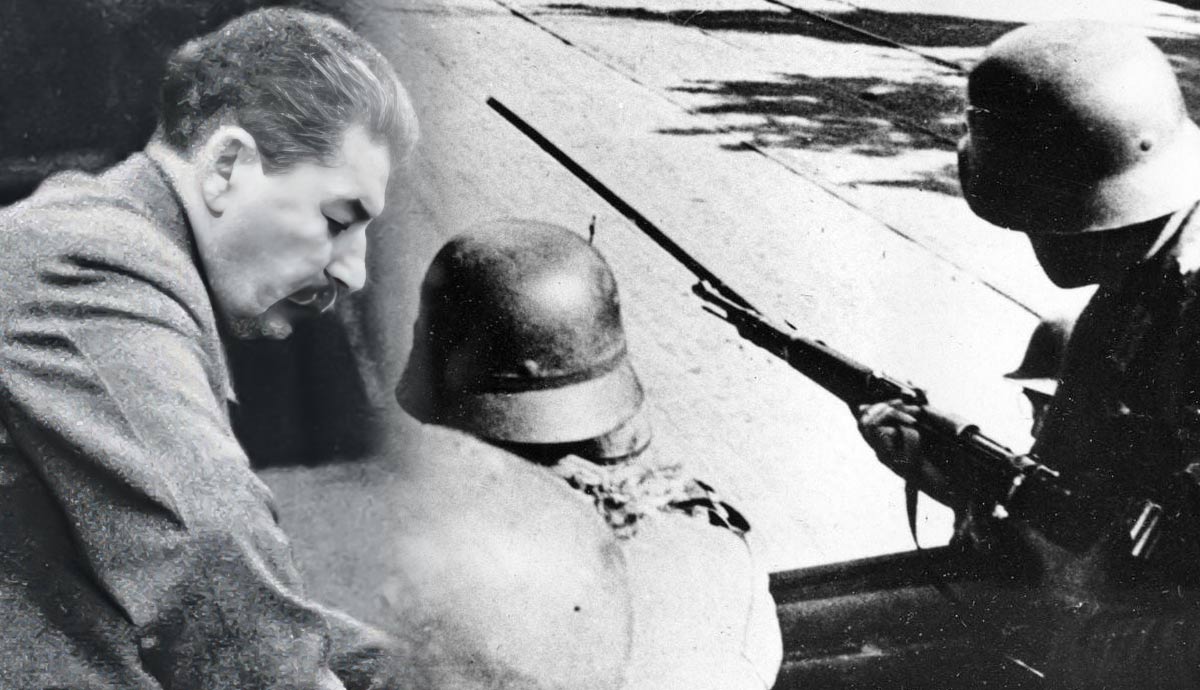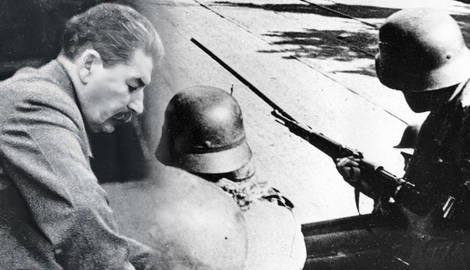
From the beginning of July to the end of September 1941, the German military conducted one of the most ambitious and impressive actions in history. Part of Operation Barbarossa—the invasion of the Soviet Union—Army Group South achieved one of Germany’s greatest victories of the Second World War when it encircled the city of Kyiv and crushed the Soviet resistance in the area.
It was a battle that was marked by German military might, Soviet inadequacies, and sweeping tank maneuvers, as well as one of the most infamous atrocities of the war.
The Battle of Kyiv (at the time known as Kiev) in 1941 marked the highpoint of German military ascendancy before it was quickly checked by Soviet resistance and the bitter winter that soon followed.
The Drive into the Ukraine

On June 22, 1941, the Germans launched the biggest invasion in history. Over three and a half million German personnel crossed the border into the Soviet Union, thus beginning the phase of the Second World War that would be characterized by the most intense brutality.
Army Group North struck out towards Leningrad while Army Group Center drove for Moscow. Army Group South, under the command of Field Marshal Gerd von Rundstedt, drove towards the area of the Ukraine. This was where the most powerful Soviet defenses lay, with no fewer than four armies protecting it, under the command of Marshal Semyon Budyonny, Marshal Semyon Timoshenko, Colonel General Mikhail Kirponos, Commissar Nikita Krushchev, and Mykhailo Burmystenko, Chairman of the Supreme Soviet of the Ukrainian SSR.

The German army surged forward at an unprecedented speed, taking casualties but inflicting many more as confusion and bad leadership ruled supreme in the Soviet efforts to defend their borders. Just four days after the invasion, the city of Lutsk fell, and the Germans pressed eastwards towards the Pripyat Marshes and Kyiv. Spearheading the attack was the powerful Panzer Group 1 under the leadership of Colonel General Ewald von Kleist, consisting of 799 tanks split between five panzer divisions and four motorized divisions, two of which were Waffen-SS.
This spearhead dealt the Soviets a stunning blow at the Battle of Brody from June 24 to June 26, where 750 German tanks defeated 3000 Soviet tanks. On June 30, Lviv fell to the Germans.

With much ground to cover, the road to Kyiv was a difficult one, especially as the Soviets had posted the bulk of their forces there. Harassed by flanking maneuvers, the Germans pursued their objectives in the south.
By August 8, the Germans had managed to encircle two Soviet armies south of Kyiv in the Uman pocket, where 100,000 Soviet troops were trapped. Meanwhile, German troops also laid siege to Odesa to the west of Crimea.
Despite the massive gains made by the Germans and the incredible losses and blunders made by their enemy, the Soviets continued to pour troops into the area, and Soviet defense began to stiffen.
Meanwhile, Army Group North also ran into rugged resistance just short of Leningrad. With these developments, Hitler decided to peel off a substantial number of divisions from Army Group Center in order to bolster the German forces on the northern and southern flanks. His generals protested this move, believing that for the operation to be successful, the capture of Moscow was of prime importance. Hitler, however, was vehement about his decision. He firmly pressed his strategy, believing it would deny the Soviets of their production facilities.
On August 21, he issued a directive ordering the capture of the Crimean Peninsula in the Donetsk Basin. Heinz Guderian, in charge of Panzer Group 2, was sent to aid the Germans in Army Group South.
The disposition of the forces when this decision was made would mean that Guderian would drive on Kyiv from the northeast while Von Runstedt was pressing in from the west. It was a perfect opportunity to attempt a massive encirclement of the Soviets in and around the well-defended city of Kyiv.
The Encirclement

By the end of August, the encirclement began to take shape. Fifty Soviet divisions were situated in a triangular area from Roslav in the north to Karosten in the west to Dnepropetrovsk in the southeast. At the points of the triangle were German armies all closing in, shrinking the area of Soviet control.
Realizing their situation, the Soviets began spirited counterattacks to slow down the encirclement, but these attacks weren’t enough to stop the relentless assaults of the German war machine. Piecemeal, uncoordinated attacks from the ill-prepared Soviets failed.

As their predicament got worse, the Soviet commanders, which included Nikita Khrushchev in command of the Kyiv garrison, reviewed their situation. Marshal Budyonny sent a telegram to Stalin requesting that armies be allowed to pull back from Kyiv. This request was denied by Stalin, and at the request of Marshal Zhukov, Budyonny was replaced with Marshal Timoshenko.
By the time this request was finally granted on September 17, it was far too late, and the Germans had already closed the noose.

On September 12, Panzer Group 1 crossed the Dnipro River and advanced north. The Soviets, focusing their attention on the rapidly advancing Germans from the north, were attacked from the rear.
Guderian’s Panzer Group 2 kept up the steady pace, advancing south. The two groups met on September 16, 118 miles east of Kyiv. Three days later, Kyiv fell, but this was not the end of the battle.

Half a million Soviet soldiers were trapped but continued to fight. The German armies pressed relentlessly, reducing the size of the cauldron each hour. Rugged resistance and spirited counterattacks from the Soviets failed to cause any opening in the enemy defense. On September 20, Kirponos died while attempting a breakout. Tired and spent, the Soviet armies surrendered on September 26.
Babyn Yar

When German forces took control of Kyiv, the worst was still to come for the city’s residents. The Soviets had organized a surprise for the Germans when they took control, and two large explosions rocked the German headquarters in the newly occupied city. This gave the Germans a pretext for the barbarism that ensued.
The brutality was genocidal and immediate. It is estimated that approximately 20 percent of Kyiv’s population was Jewish at the time. This accounted for around 160,000 Jewish people.
SS soldiers from the Einsatzgruppen took care of the extermination. In the first two days, they killed 33,771 Jews, Roma, communists, and Soviet soldiers.
The victims were marched to Babyn Yar, a ravine to the northwest of the city, and shot. Over 100,000 people were murdered and disposed of at this location by the Nazi regime. It is the site of one of the biggest massacres in the Second World War.
Casualties

Among conflicting reports from German and Soviet forces, it is difficult to establish an accurate figure of the number of casualties suffered in and around Kyiv in 1941. The German reports at the time stated that 665,212 prisoners had been taken, along with 824 tanks destroyed or captured and 3,436 artillery and anti-tank guns destroyed or captured.
The official Soviet claims were that no more than 222,000 soldiers were captured. There is no official record of German losses, but they are believed to have been significant, although nowhere near as devastating as the Red Army losses. According to ww2stats.com, the Germans suffered 12,728 killed, 46,480 wounded, and 2,085 missing.
Whatever the truth, four Soviet field armies were completely destroyed and removed from the battlefield.

Among civilians, the casualties would be immense during the German occupation. Those immediately targeted by the Germans were wholesale slaughtered, while in the following months, the Germans implemented a policy of slow starvation, which they would try to blame on Soviet food policies.
Despite Hitler’s order that the city be completely razed, Kyiv was spared. Unsurprisingly, this failure to follow his orders infuriated the Führer. German commanders could find no pretext to carry out this order, as there had actually been no fighting in the city.
In the rest of Ukraine, the Germans used the Holodomor as a propaganda tool to rally Ukrainian nationalist sentiment against the Soviets, whom the Germans linked to Jewish people. As a result, many Ukrainian nationalists provided support for the Nazi regime.
Aftermath

The encirclement of Kyiv was a complete and unprecedented disaster for the Soviets. It was their biggest defeat during the war and Germany’s biggest victory. It caused the complete collapse of the Soviet defense on the southwestern front, and troops had to be pulled from the defense of Moscow to reinforce what little was left in the south.
At this point, the German war machine seemed completely invincible. Morale plummeted among the Soviets, while for the Germans, their belief in their superiority seemed to be vindicated. This resulted in an overconfidence that led the Germans to make huge mistakes. Hitler referred to the battle as “the greatest battle in the history of the world.”
The silver lining for the Soviets was that the operations around Kyiv resulted in the German advance on Moscow being delayed for an entire month. When the German advance continued, the autumn rains turned the roads to mud and slowed the advance to a crawl as vehicles became bogged down.
After this, the winter and the iron will of the Soviet people stopped the German advance, and Moscow avoided being captured.
The Battle of Kyiv represents the last great breakthrough of the German forces. They would never again see such a stunning victory, while the Soviets recovered in the following months and years, going from strength to strength, pushing through 1942, and experiencing significant victories against their enemies at Stalingrad and Kursk in 1943, which completely turned the tide of the war. 1943 also saw the liberation of Kyiv as the Soviets pushed the Germans back.

The Battle of Kyiv was Germany’s last great victory. Ensuring this victory, however, meant that German forces had to be taken from Army Group Center. It has been argued by strategists and academics that this move cost Germany the war.
On a strategic level, it was Hitler’s greatest success and his greatest blunder.










